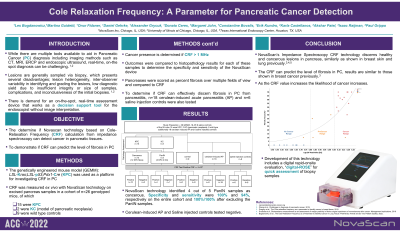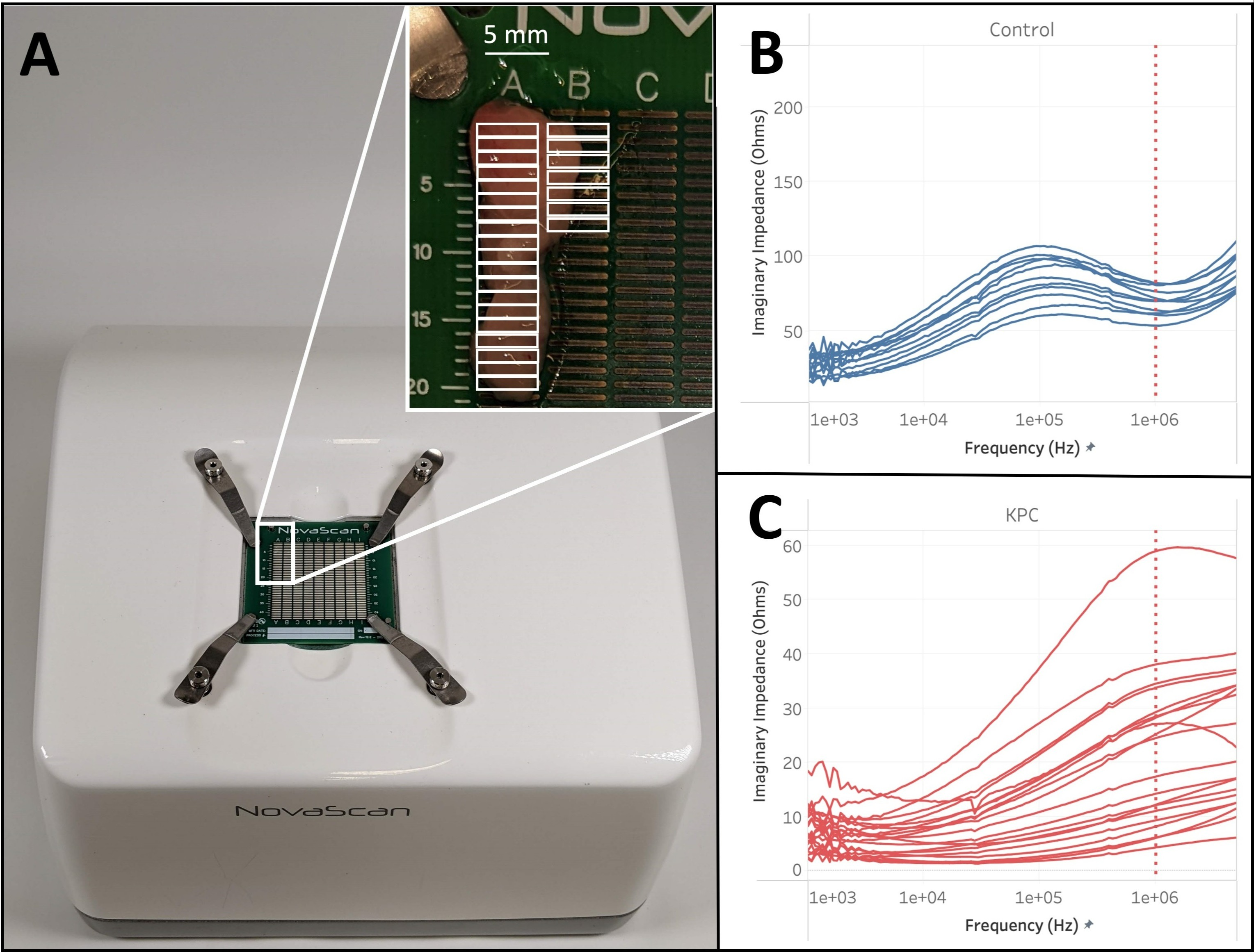Back


Poster Session D - Tuesday Morning
Category: Biliary/Pancreas
D0021 - Cole Relaxation Frequency: A Parameter for Pancreatic Cancer Detection
Tuesday, October 25, 2022
10:00 AM – 12:00 PM ET
Location: Crown Ballroom

Has Audio

Les Bogdanowicz, PhD, MBA
NovaScan Inc.
Chicago, IL
Presenting Author(s)
Les Bogdanowicz, PhD, MBA1, Martina Guidetti, PhD1, Onur Fidaner, PhD1, Daniel S. Gehrke, BS1, Alexander Grycuk, BS1, Donato Ceres, PhD1, Margaret C. John, MS1, Constantine Bovalis, BS1, Erik Kundro, MS1, Isaac Raijman, MD2, Paul Grippo, MS, PhD3, Karla J. Castellanos, PhD, MS3, Akshar Patel, BS3
1NovaScan Inc., Chicago, IL; 2Texas International Endoscopy Center, Houston, TX; 3University of Illinois at Chicago, Chicago, IL
Introduction: Pancreatic cancer (PC) accounts for half a million new cases and 4.7% of the world's cancer-related deaths in 2020. It is considered one of the most lethal malignancies with a global survival rate of only 5%. Innovative imaging and endoscopic techniques are being studied to improve the accuracy of PC detection. Endoscopic ultrasound (EUS) guided tissue acquisition is currently the gold standard for sampling pancreatic masses. EUS guided fine needle biopsy has been considered superior to fine needle aspiration, but both are limited by the subjectivity of endoscopists and invasiveness of the procedure. Nonetheless, at present, there is no standard procedure for PC detection. The Cole Relaxation Frequency (CRF) – a derived electrical bioimpedance signature for cancer detection proposed by NovaScan – has been proven to quantitatively detect cancer in breast, skin, and lung tissues. The aim of this pilot study was to determine if the CRF based NovaScan technology can detect cancer in pancreatic tissues.
Methods: CRF was measured with NovaScan technology in multiple locations (Figure 1.A) on the pancreas samples in a cohort of n=26 mice, of which 15 were KPC (model of pancreatic ductal adenocarcinoma), 2 were KC (model of pancreatic neoplasia), and 9 were wild type controls. NovaScan determined cancer presence when the CRF parameter was measured above 1 MHz (Figure 1.B,1.C). Outcomes were compared to histopathology results for each of these samples to determine the specificity and sensitivity of the NovaScan device.
Results: From histology, 12 KPC pancreases were confirmed as cancerous, 9 controls were confirmed as noncancerous, while 5 pancreases (3 KPC and 2 KC) presented with pancreatic intraepithelial neoplasia (PanIN), a precancerous condition. NovaScan technology identified 4 out of 5 PanIN samples as cancerous. Considering the entire cohort (n=26), specificity and sensitivity were 100% and 94%, respectively. If PanIN samples were excluded, specificity and sensitivity were both 100% (n=21).
Discussion: Future development of NovaScan CRF based technology into a rapid onsite evaluation or an endoscopic device would provide an affordable means for accurate and quantitative PC detection that guides or substitutes pancreatic biopsy acquisition. Identification of malignant precursors indicates the technological capability of NovaScan’s device to detect early stage PCs. Further technology development could allow for the distinction between cancerous and precancerous lesions.

Disclosures:
Les Bogdanowicz, PhD, MBA1, Martina Guidetti, PhD1, Onur Fidaner, PhD1, Daniel S. Gehrke, BS1, Alexander Grycuk, BS1, Donato Ceres, PhD1, Margaret C. John, MS1, Constantine Bovalis, BS1, Erik Kundro, MS1, Isaac Raijman, MD2, Paul Grippo, MS, PhD3, Karla J. Castellanos, PhD, MS3, Akshar Patel, BS3. D0021 - Cole Relaxation Frequency: A Parameter for Pancreatic Cancer Detection, ACG 2022 Annual Scientific Meeting Abstracts. Charlotte, NC: American College of Gastroenterology.
1NovaScan Inc., Chicago, IL; 2Texas International Endoscopy Center, Houston, TX; 3University of Illinois at Chicago, Chicago, IL
Introduction: Pancreatic cancer (PC) accounts for half a million new cases and 4.7% of the world's cancer-related deaths in 2020. It is considered one of the most lethal malignancies with a global survival rate of only 5%. Innovative imaging and endoscopic techniques are being studied to improve the accuracy of PC detection. Endoscopic ultrasound (EUS) guided tissue acquisition is currently the gold standard for sampling pancreatic masses. EUS guided fine needle biopsy has been considered superior to fine needle aspiration, but both are limited by the subjectivity of endoscopists and invasiveness of the procedure. Nonetheless, at present, there is no standard procedure for PC detection. The Cole Relaxation Frequency (CRF) – a derived electrical bioimpedance signature for cancer detection proposed by NovaScan – has been proven to quantitatively detect cancer in breast, skin, and lung tissues. The aim of this pilot study was to determine if the CRF based NovaScan technology can detect cancer in pancreatic tissues.
Methods: CRF was measured with NovaScan technology in multiple locations (Figure 1.A) on the pancreas samples in a cohort of n=26 mice, of which 15 were KPC (model of pancreatic ductal adenocarcinoma), 2 were KC (model of pancreatic neoplasia), and 9 were wild type controls. NovaScan determined cancer presence when the CRF parameter was measured above 1 MHz (Figure 1.B,1.C). Outcomes were compared to histopathology results for each of these samples to determine the specificity and sensitivity of the NovaScan device.
Results: From histology, 12 KPC pancreases were confirmed as cancerous, 9 controls were confirmed as noncancerous, while 5 pancreases (3 KPC and 2 KC) presented with pancreatic intraepithelial neoplasia (PanIN), a precancerous condition. NovaScan technology identified 4 out of 5 PanIN samples as cancerous. Considering the entire cohort (n=26), specificity and sensitivity were 100% and 94%, respectively. If PanIN samples were excluded, specificity and sensitivity were both 100% (n=21).
Discussion: Future development of NovaScan CRF based technology into a rapid onsite evaluation or an endoscopic device would provide an affordable means for accurate and quantitative PC detection that guides or substitutes pancreatic biopsy acquisition. Identification of malignant precursors indicates the technological capability of NovaScan’s device to detect early stage PCs. Further technology development could allow for the distinction between cancerous and precancerous lesions.

Figure: (A) KPC pancreas sample placed on Novascan’s electrode array for a series of spectral bioimpedance measurements. A zoom in of the electrode with a pancreas sample is also shown. White rectangles indicate multiple locations measured across the sample. Spectral impedance scans for a control mouse (B) and a KPC mouse (C). The examination of CRF peak properties was used for cancer identification in pancreas samples. For the control mouse the CRF peaks fall below the threshold of 1 MHz, determining no cancer. For the KPC mouse several scans have CRF peaks above the threshold of 1 MHz, determining cancer presence.
Disclosures:
Les Bogdanowicz indicated no relevant financial relationships.
Martina Guidetti indicated no relevant financial relationships.
Onur Fidaner: Novascan Inc – Employee.
Daniel Gehrke indicated no relevant financial relationships.
Alexander Grycuk indicated no relevant financial relationships.
Donato Ceres indicated no relevant financial relationships.
Margaret John indicated no relevant financial relationships.
Constantine Bovalis indicated no relevant financial relationships.
Erik Kundro: Invictus Electronics Design – Consulting business working with medical device companies.
Isaac Raijman: Boston Scientific Corporation – Advisor or Review Panel Member, Consultant. ConMed – Speakers Bureau. EndoRx – Owner/Ownership Interest. Endosound – Advisory Committee/Board Member. Medtronic – Speakers Bureau. Microtech – Advisory Committee/Board Member. Pentax – Advisory Committee/Board Member.
Paul Grippo indicated no relevant financial relationships.
Paul Grippo — NO DISCLOSURE DATA.
Karla Castellanos indicated no relevant financial relationships.
Akshar Patel indicated no relevant financial relationships.
Les Bogdanowicz, PhD, MBA1, Martina Guidetti, PhD1, Onur Fidaner, PhD1, Daniel S. Gehrke, BS1, Alexander Grycuk, BS1, Donato Ceres, PhD1, Margaret C. John, MS1, Constantine Bovalis, BS1, Erik Kundro, MS1, Isaac Raijman, MD2, Paul Grippo, MS, PhD3, Karla J. Castellanos, PhD, MS3, Akshar Patel, BS3. D0021 - Cole Relaxation Frequency: A Parameter for Pancreatic Cancer Detection, ACG 2022 Annual Scientific Meeting Abstracts. Charlotte, NC: American College of Gastroenterology.
